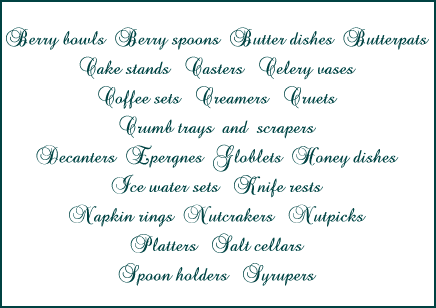Dressing for the Occasion
Imitating the wealth and adopting the social patterns of the
English were fashionable among the comfortably off middle class
in the closing years of the 19th century. Formal dress was
expected for any occasion after 6 p.m. Ladies wore low-necked,
short sleeved gowns (and gloves - until they were seated at the
table). At larger dinners, matrons appeared in satin, silk or
spangles or embroidered laces. Young ladies chose daintier sheer
muslins or chiffon. Etiquette books advised gentlemen to wear
dark broadcloth and "fine linen."
Dinner Escorts
As soon as he arrived, the male guest was told by his
hostess, or by a card on the hall table, whom he would escort
into the dinning room. After stilted preliminary conversation,
the host led his guests into the dinning room with his companion
"on his left arm." According to custom, this honor
went to the oldest or most distinguished lady, a stranger in the
community, a recent bride, or the wife of the most prominent
guest. The hostess entered the dining room last on the arm of
the husband of her husband's partner.
The Lavish Dining Room
The Victorian dinning room was a large and heavily decorated
room. The Social Mirror, stated that it "should be
furnished with a view to convenience, richness and
comfort." It suggested walls of bronze, maroon, or black.
Propeian red or deep olive, with designs, dado and frieze in old
gold, olive or moss-green, and wainscoting on the walls and
ceiling. Prompeian red and soft olive were recommended for
draperies. Dark woods should be used. A buffet may stand in a
corner for the display of ceramics, or decorated china. The
sideboard should be of high, massive style with selves and racks
for glassware and china. A cage of stuffed birds, a few large
pots of tropical plants and a fernery are in keeping. A folding
screen should not be forgotten. But it was the lavishly
appointed table that riveted attention.
The Well Dressed Table
The number of articles that appeared on a properly set
Victorian dinner table seems staggering today. For the dinner
hostess of the late 1800s, every piece of table silver, china
and stemware had its appointed place. It was not unusual for
some 24 pieces of silver to be at each place setting. As many as
eight forks might be expected, from a fish fork and dinner fork
to an ice cream fork. Knives could add up to eight: for butter,
cheese, game, roast, and fruit, all accompanied by individual
knife rests. A complete formal setting also included a butter
pick and individual game shears. All the stemware that would be
needed through the meal was placed on the table beforehand. It
was arranged in two rows: top row. from left to right: water
glass, glass for chambertin, glass for latour, champagne glass;
bottom row, from left to right: green glass for sauterne, sherry
glass, and a red glass for Rhine wine. A thin, unbuttered slice
of bread rested on a napkin to the left of the plate with an
individual salt close by. It was suggested that the dining table
allow a foot of space for each guest! In the center of the table
stood an elaborate floral centerpiece. At either side of the
centerpiece was a stand filled with fresh fruits, and a
compotier of assorted little cakes stood beside each fruit
stand. Dishes of celery, olives or radishes filled the remaining
space on the table. These additional items were also found on
many Victorian tables:

The Dinner Menu
Victorian Dinners, in particular are quite well know for the
endless procession of soups, meats, salads, pudding, ices, and
meringues or pastries. It was not unusual for a Victorian Dinner
menu to be nine courses, with plenty of time allowed between
each course to permit each guest to fully enjoy the variety of
courses. The following is a sample menu of a six course
Victorian Dinner Party based on one designed in 1887 by Maria
Parloa, founder of a cooking school. Miss Parola's original
dinner recipes would have required a pound of butter, almost a
dozen eggs and two quarts of cream.

Retiring from the Table
Finger bowls with a sliver of lemon in the water signaled the
end of the meal. The bowls were dainty glass affairs set on
linen or lace doilies nestled onto small plates. When the
hostess was sure her guests were ready to retire form the table,
she "looks significantly" at the lady seated to the
host's right. She then rose and the gentleman seated most
conveniently (or a servant) opened the door for the departing
women. The ladies retired to the drawing room while the men
lingered in the dining room or retired to the library for cigars
and port.
Calling Etiquette
Proper Victorian etiquette required that a call should be
made upon the hostess within a week . . . by all who have been
honored by an invitation, whether accepted or not. Gentlemen
whose time is much absorbed in business . . . may send their
cards by their wives or lady relatives.
|